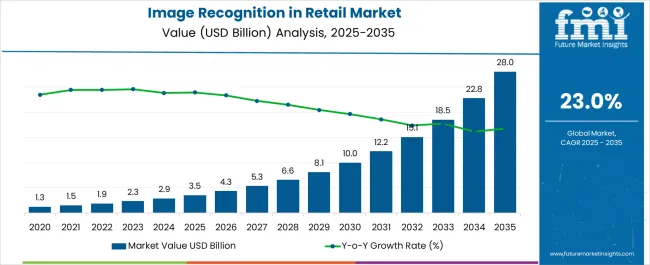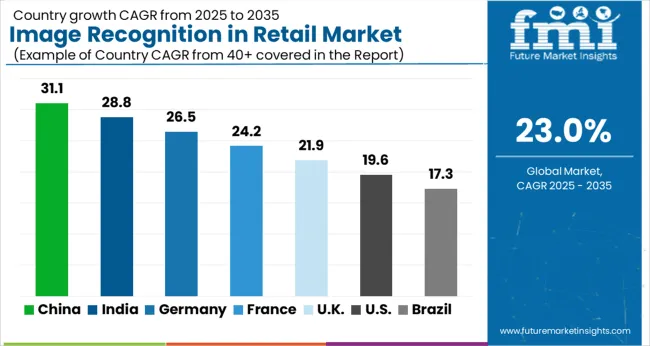The Image Recognition in Retail Market is estimated to be valued at USD 3.5 billion in 2025 and is projected to reach USD 28.0 billion by 2035, registering a compound annual growth rate (CAGR) of 23.0% over the forecast period.

| Metric | Value |
|---|---|
| Image Recognition in Retail Market Estimated Value in (2025 E) | USD 3.5 billion |
| Image Recognition in Retail Market Forecast Value in (2035 F) | USD 28.0 billion |
| Forecast CAGR (2025 to 2035) | 23.0% |
The image recognition in retail market is expanding rapidly owing to the rising adoption of artificial intelligence and computer vision technologies that enhance operational efficiency and customer engagement. Retailers are increasingly deploying image recognition solutions to streamline inventory management, optimize checkout experiences, and strengthen loss prevention strategies.
Growing emphasis on personalized shopping journeys and data driven merchandising is fueling investments in hardware and software integrations. Additionally, the surge in omnichannel retailing and the need for seamless customer experiences are pushing retailers to adopt digital imaging technologies that ensure real time insights and accuracy.
The outlook remains promising as advancements in machine learning, cloud based analytics, and mobile commerce integration continue to support innovation and scalability in the retail ecosystem.
The hardware segment is projected to contribute 47.60% of overall market revenue by 2025, establishing itself as the leading component. This dominance is driven by the increasing demand for advanced cameras, sensors, and point of sale devices that support high quality image capture and processing.
Hardware enables reliable real time data collection, which is essential for applications such as automated checkout, shelf monitoring, and in store analytics. Retailers have been prioritizing hardware investments due to the need for robust infrastructure capable of handling high volumes of data with accuracy.
The ability of hardware to integrate seamlessly with AI powered platforms has further strengthened its adoption, ensuring consistent performance and cost efficiency.
Digital image processing is expected to represent 55.20% of total revenue by 2025 within the technology category, making it the dominant segment. Its leadership stems from its ability to deliver advanced image enhancement, feature extraction, and pattern recognition capabilities.
Retailers rely on this technology for accurate product identification, facial recognition based customer engagement, and security monitoring. The scalability and compatibility of digital image processing with cloud infrastructure and AI driven platforms have further accelerated its deployment.
This segment continues to gain traction as retailers emphasize accuracy, automation, and personalization in customer centric strategies.
The scanning and imaging application segment is anticipated to hold 42.90% of total market revenue by 2025, positioning it as the largest application. Growth is being propelled by the need for efficient barcode scanning, visual merchandising, and real time shelf management in retail environments.
Scanning and imaging technologies enable accurate tracking of stock keeping units, enhance inventory visibility, and support quick checkout solutions. Their contribution to reducing shrinkage, improving store operations, and creating a smoother customer experience has made them central to modern retail practices.
As digital transformation accelerates across global retail chains, this application segment is expected to retain its dominance through its operational impact and customer centric benefits.
Drivers
Increasing use of image recognition applications such as scanning & imaging, security & surveillance, marketing & advertising, are fueling the growth of the image recognition in retail market. The growing need for improving the accuracy of the biometric authentication process, drives the image recognition in retail market growth.
Furthermore, the rising demand for big data analytics and the need for product brand recognition in retail sectors, are major factors expected to fuel the new growth opportunities in the market. Image recognition in retail offers different benefits such as auditing product placement, detecting trends in product placement, assessing compliance and competition, and category analysis.
The reliability of such benefits drives the Image recognition in retail market growth.
Challenges
However, the image recognition in retail market is also impacted significantly when the scanning process is not perfect due to poor lighting, blur, motion, or even physical problems.
Also, high cost of installation of image recognition systems, as well as technical issues regarding the compatibility with existing systems, are some of the factors challenging the growth of image recognition in retail market.

Some of the prominent players providing image recognition solutions in retail are

By geography, the image recognition in retail market has been segmented into North America, Europe, Latin America, East Asia, South Asia & Pacific, and Middle East & Africa. The market is currently dominated by Europe followed by North America, due to the advancements in image recognition technologies by the prominent vendors in these regions.
Moreover, Asia Pacific holds a comparatively higher market CAGR in the global image recognition in retail market, due to the growing advancements in the field of digital shopping and e-commerce, in this region.
The image recognition in retail market report is a compilation of first-hand information, qualitative and quantitative assessment by industry analysts, and inputs from industry experts and industry participants across the value chain.
The report provides in-depth analysis of parent market trends, macro-economic indicators, and governing factors, along with market attractiveness as per segment. The image recognition in retail market report also maps the qualitative impact of various market factors on market segments and geographies.
The global image recognition in retail market is estimated to be valued at USD 3.5 billion in 2025.
The market size for the image recognition in retail market is projected to reach USD 28.0 billion by 2035.
The image recognition in retail market is expected to grow at a 23.0% CAGR between 2025 and 2035.
The key product types in image recognition in retail market are hardware, software and services.
In terms of technology, digital image processing segment to command 55.2% share in the image recognition in retail market in 2025.






Full Research Suite comprises of:
Market outlook & trends analysis
Interviews & case studies
Strategic recommendations
Vendor profiles & capabilities analysis
5-year forecasts
8 regions and 60+ country-level data splits
Market segment data splits
12 months of continuous data updates
DELIVERED AS:
PDF EXCEL ONLINE
Image Guided Radiotherapy Market Size and Share Forecast Outlook 2025 to 2035
Image Guided Systems Market is segmented by product type, application and end user from 2025 to 2035
Imagery Analytics Market Analysis – Growth & Forecast through 2034
Image Sensors Market Growth – Trends & Forecast through 2034
Image Based Barcode Reader Market Growth – Trends & Forecast 2020-2030
Image-Based Cytometer Market
Image Intensifier Market Analysis - Size, Share & Forecast Outlook 2025 to 2035
Image-Guided Injectables Market Forecast and Outlook 2025 to 2035
AI Image Editor Market Forecast and Outlook 2025 to 2035
InGaAs Image Sensors Market
Contact Image Sensor Market
Geospatial Imagery Analytics Market Size and Share Forecast Outlook 2025 to 2035
Distance Measurement Image Sensor Market Size and Share Forecast Outlook 2025 to 2035
Iris Recognition Market Size and Share Forecast Outlook 2025 to 2035
Facial Recognition Market Size and Share Forecast Outlook 2025 to 2035
Facial Recognition Machine Market
Gesture Recognition Market
Employee Recognition Software Market Analysis - Size, Share, and Forecast 2025 to 2035
EHR Speech Recognition Solution Market Size and Share Forecast Outlook 2025 to 2035
Traffic Sign Recognition System Market Size and Share Forecast Outlook 2025 to 2035

Thank you!
You will receive an email from our Business Development Manager. Please be sure to check your SPAM/JUNK folder too.
Chat With
MaRIA